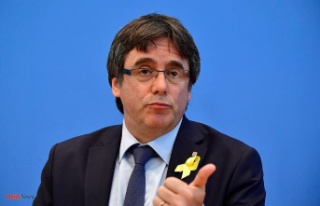“Full employment” is the watchword of Emmanuel Macron, who promised to reach 5% unemployment in 2027. It is also the title of the law passed in December which modifies support for the unemployed and imposes working hours on RSA recipients, arousing the anger of the unions. Achieving full employment ensures billions of euros in additional revenue for the State: more employee contributions, fewer unemployment benefits paid.
INSEE announced Thursday February 29 that salaried employment had not changed (0%) in the fourth quarter of 2003, with an increase of 0.6% over one year, while the unemployment rate also stabilized at 7 .5% of the active population in the same quarter, after reaching a low of 7.1% in mid-2023. Stable indicators, but far from the objectives set by the President of the Republic.
What are the differences between these indicators to measure employment health? Why set a target of 5% unemployment? What are the political implications of each of these statistics? Explanations
What indicators to determine full employment?
Economists speak of full employment when individuals who wish to work have no difficulty finding a position. To define this term, they restrict the population to active people, that is to say people who are of working age (between 15 and 64 years, in the majority of international comparisons), who carry out an activity or who are looking for a job. This excludes people at home without professional activity, but also children, students and retirees.
Then, economists do not all agree on the metric to use: the activity rate, employment or unemployment? These are three different indicators, each with its own method of calculation:
What is the “minimum” unemployment rate?
Currently, unemployment remains the standard for defining full employment. In May 2023, with a rate close to 7%, the President of the Republic congratulated himself: “It has been forty years since the level of unemployment had been so low. Full employment goal! » But what unemployment are we talking about? The International Labor Organization distinguishes five types of unemployment:
The frictional unemployment rate is the one that defines full employment: a threshold below which we cannot go. It corresponds to the time it takes for a worker to find a job or for an employer to recruit. “We can always try to reduce it by improving the dissemination of information on job offers, recruitment processes, but it is difficult,” explains economist Christine Erhel, director of the Center for Studies of the employment and work.
Currently, economists agree on a frictional unemployment rate between 4.5% and 5% for France. But the calculations may vary depending on the assumptions made to measure it, the period and the geographical area used. In the 2000s, the economist Jean Pisani-Ferry, using an average search time for a new job of three months for people who have already worked, and six months for new entrants to the labor market, estimated the frictional unemployment rate at 3.4%, and the “step unemployment” to get there at 5%. In Germany, Chancellor Angela Merkel promised for her last mandate to reduce unemployment to its incompressible minimum, putting it at 3%.
Is the employment rate more reliable?
According to some economists, we should stop defining full employment by counting the unemployed and instead shine the spotlight on people who are working. In March 2000, European heads of state meeting in Lisbon adopted a full employment objective which, contrary to its traditional conception, was not given “in the form of an unemployment rate (which we would aim for to be reduced to a minimum deemed incompressible), but below that of an employment rate that we propose to increase,” recalled economist Jacques Freyssinet in a 2004 publication.
To have growth, you need a high employment rate that generates wealth. However, we can have a falling unemployment rate without the employment rate increasing, if the activity rate falls at the same time, with people leaving the labor market, out of discouragement, for health problems or to retire. “We saw this phenomenon very clearly in the United States after the “great recession” [2007-2008], explains Christine Erhel. Unemployment has fallen, but, at the same time, the employment rate has also fallen due to numerous withdrawals from the labor market, so we could not in reality speak of a return to full employment, the situation is remained below the pre-crisis level for a very long time. »
But neither the employment rate nor the activity rate takes into account underemployment, that is to say people who work less than they want, due to part-time work or partial unemployment. . A country can move closer to full employment by allowing precarious contracts to develop, with a high level of underemployment. To avoid this overvaluation bias, Mr. Freyssinet suggests instead calculating a full-time equivalent employment rate.
What political strategy is behind these figures?
While the reality of work becomes more and more complex with the appearance of numerous intermediate situations and the development of atypical forms of employment (very short contracts, forced part-time work, independent work, etc.), the majority of economists agree on the importance of combining several indicators to clearly understand the contours of full employment.
Hesitations in the choice of indicators are also found on the government side. Thus, Emmanuel Macron announced in April 2023, his ambition to achieve “full employment of seniors” by putting forward an employment rate objective of 65% for those aged 60 to 64 “by 2030”, then that it was only 36.2% in 2022.
This choice can also be seen as a communications trick: with the increase in retirement age, the unemployment rate which affects this age group will initially increase since the number of active workers (the denominator) will be increased mechanically, before the employment rate rebounds.
Furthermore, focusing solely on a very sharp drop in the unemployment rate can have the side effect of fueling overheating of prices. This is also why the structural unemployment rate (frictional unemployment to which unemployment linked to labor market rigidities is added) is also called in English "Nairu", for non-accelerating inflation rate of unemployment. unemployment below which inflation risks accelerating.
The target of 5% irreducible unemployment must be considered “as an objective, which reflects the ambition to reduce unemployment in a fairly historic way”, explains Alexandra Roulet, professor of economics at the European Institute of Business Administration and former macroeconomics advisor at the Elysée. For her, a drop below 7% would already be “a great victory”.












